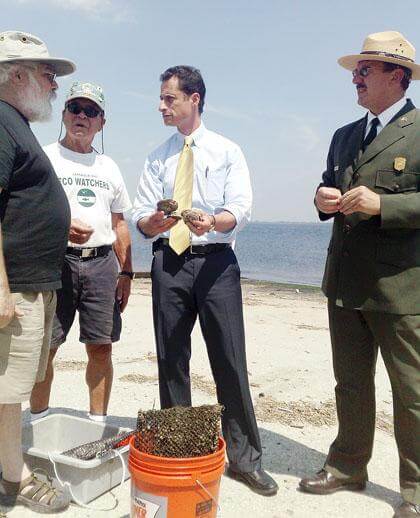By Gary Buiso, Courier-Life
A study unveiled this week is designed to determine whether Jamaica Bay is clean enough to one day make both oysters and environmentalists happy as clams.
Researchers held a news conference Monday to talk about an ongoing study to see if the native oyster larvae can exist in the bay and whether they can thrive in its polluted waters.
“This is a preliminary investigation to see how well they live,” said Professor Jeffrey Levinton, lead investigator and marine biologist at SUNY Stony Brook.
On Monday, after about a year of study and preparation, researchers seeded the bay with adult oysters confined in a series of eight cages. The hope is that the presence of mature oysters will encourage the growth of native oyster larvae, which have disappeared because of pollution and overharvesting during the last century.
During the next two years, scientists will determine whether the adults have larvae attached to their shells — the only way for the immature bivalves to grow.
Over the first year of the three-year study, Levinton said he has already seen that the mollusks are able to survive in the water — an encouraging sign.
“What we know now is that they grow extremely well and survive extremely well,” he said.
Oysters could help improve water quality in Jamaica Bay, a recipient of 250 million gallons of treated wastewater each day from four wastewater treatment facilities that line its 39 square miles. The wastewater is thought to contribute to the bay’s low levels of oxygen and high levels of nitrogen, an inhospitable condition for aquatic creatures.
“A mature oyster can filter 35 to 50 gallons of water per day. That’s quite a good pump,” said Dan Mundy, founder and president of the Jamaica Bay Eco Watchers, a group working with scientists on the study. Oysters are vegetarians, feeding on algae, a plant-like organism that contributes to the bay’s nitrogen problem.
The study is funded by the National Parks Service, the Hudson River Foundation, and the National Fish and Wildlife Foundation, Levinton said. He said preliminary work is costing in the neighborhood of “low hundreds of thousands of dollars.”
The creatures, Levinton emphasized, are strictly off-limits to prospective diners. “This is for ecological restoration — not as a food item,” he said.
U.S. Rep. Anthony Weiner (D-Forest Hills), a member of the House Energy and Commerce Committee, joined researchers at Gateway National Park for the announcement. “Bringing oysters back to the bay is one of the best things we can do for the estuary ecosystem. After over a century of absence, it’s time for oysters to return to Jamaica Bay,” the lawmaker said in a statement.
If the bivalves are comfortable enough to reproduce, a more extensive re-seeding could be the next step. But the work will take time: It takes roughly two to three years for oysters to mature.
“We realize it will take a while, but this is an exciting thing,” Mundy said. Everyone can relate to an oyster,” he said.


































